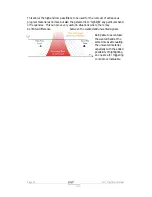
Page 16
G2
Operators Manual
An expander can be used to improve the noise floor under all these circumstances, by
attenuating signals below a set threshold, thereby improving the clarity of the signal
fed to it.
One other area where expander can prove useful is in the control of feedback in a
live situation. In the case of a vocal microphone, leaving it ‘open’ all the time is likely
to cause problems not only with the pick-up of extraneous noise, but allowing
feedback paths to build up. Whilst the vocalist is actually using the microphone, their
voice effectively stops all other sounds from entering. By attenuating the output from
the microphone during pauses, the build up of feedback can be avoided.
How does a Expander work?
Consider again the signal burst shown below. Regions 1 and 3 are set to below the
threshold of the expander, and will consequently be attenuated by an amount
equating to the Ratio parameter. In region 2, the signal has risen to a level above the
threshold, and so the expander will stop attenuating, and allow the signal to pass
straight through. The difference between the attenuated signal when below the
threshold and the original signal level (i.e. the degree of attenuation) is set by the
Ratio.
Continuing with the
compressor analogy
again – the ratio can be
determined by
considering the degree
of attenuation required.
If the signal drops to
6dB below the
threshold, and the
ratio is set to 2:1, then
the actual output will
be 12dB down.
The expander is equipped with a set of envelope controls, which allow adjustment of
how it reacts to the signal as it crosses the threshold.
Содержание G2
Страница 1: ......













































